
Last week, Sonos, Inc. (Nasdaq: SONO) announced the results for its third quarter of Fiscal Year 2024. CEO Patrick Spence must feel like the tech company can’t catch a break. The company successfully launched its first headphone product, Sonos Ace, to much fanfare in June – the load-in of which helped to drive better-than-expected results for the 3rd quarter of Fiscal 2024. And yet the company’s launch of its newest totally “re-architected” app turned into an unmitigated disaster – infuriating dealers and consumers alike and spoiling all of the positive momentum from Ace and the improved quarter.
What’s worse, the company warns financial analysts that the app disaster will likely continue, causing the company to push back the launch of two new products planned for the 4th quarter and to downwardly revise sales and profit forecasts for the next quarter and the full fiscal year. The ugliness, according to the company, will likely continue into the 1st quarter of Fiscal 2025. Ouch!
See more on the Sonos Q3 results, and the ongoing app disaster impact
To its credit, Sonos did not try to hide from the app disaster that is engulfing the company since it sought to engage in a completely overhauled “from the ground up” redesign of the Sonos app that runs its products and systems. There was no denying what has been a surprisingly bungled new app launch process. I have been tracking various consumer online forums and they have been unbelievably coarse and even profane as consumers are furious about an app update that has caused their systems to lose functionality or, in some cases, not operate at all.
Earnings Report Starts with a Statement from the CEO
So instead of the usual flashy, graphic-rich, glitzy presentation of its results, this time, Sonos got right down to business. The release announcing the earnings results for the quarter began with a prepared statement from CEO Patrick Spence.
Thanks to Ace, our long-awaited entry into headphones, we reported year over year revenue growth and delivered results that slightly exceeded our expectations in our third quarter. This was overshadowed by the problems that our customers and partners experienced as a result of the rollout of our new app, which in turn has required us to reduce our Fiscal 2024 guidance. We have a clear action plan to address the issues caused by our app as quickly as possible. While our app setback is regrettable, it is one chapter in our over twenty years of delighting customers. I speak for everyone at Sonos when I say that our #1 priority is to make this right and ensure that the next chapter is even better than the previous ones.
Patrick Spence, Sonos CEO
A Positive Financial Result Offset By An App Disaster
This is a brutal way to start your earnings report…but honest. On the one hand, this is the first quarter in almost two years where they showed reasonable growth (revenues in the quarter were up 6.4% YoY); on the other hand, the app disaster has gripped the company and is taking its toll. The company was forced to admit that Q4 results would be lower than expected, as would results for the full fiscal year.
In any event, let’s turn our attention to the 3rd quarter results, for the ninety-day period that ended on June 29, 2024 (compared to the same quarter last year that ended July 1, 2023). We’ll come back to the perplexing app disaster later.
Thanks to Ace, Revenues Finally Increase
For the first time in many quarters, the company finally reported a year-over-year (YoY) increase in revenues in the quarter. The company clearly points to the launch of Ace, its new premium headphone model, as the primary reason for the growth. It also notes that Ace’s success was “partially offset by softer demand across all regions and challenging market conditions.”
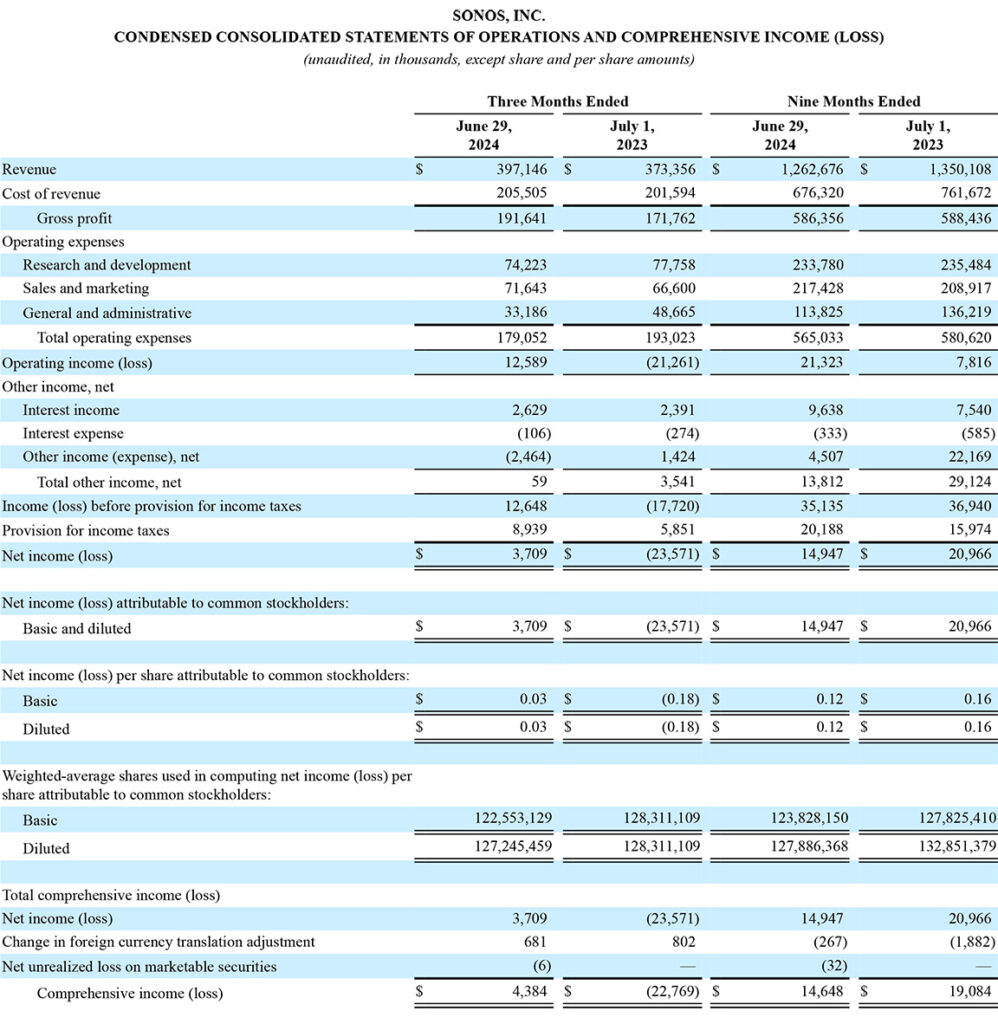
Total revenues in the quarter came in at $397.1 million, $23.8 million or 6.4% higher than revenues of $373.4 million in the same quarter a year ago. That is welcome growth and was surely what the company hoped would be a turning point for revenues going forward.
While Q3 Revenues Improved, YTD Revenues are Still Challenged
However, it is worth noting that on a year-to-date basis, the company’s total revenues of $1.263 billion represent a decline of $87.4 million or 6.5% for the first three quarters of this year versus total revenues of $1.350 billion in the first nine months of last year. And, as I mentioned earlier, thanks to the self-inflicted damage from the app rollout disaster, the company anticipates a down 4th quarter and fiscal year. An ignominious conclusion to what was supposed to be the turnaround year for the company.
By the way, as in discussing the results in the quarter, Sonos also noted that the YTD revenue decrease was “primarily due to softer demand across all regions and challenging market conditions, as well as declines in our retail and other channels as our channel partners normalized ordering levels.” Yes, Ace helped a little, but the trend for the year still remained really tough.
Disaggregated Revenues by Product Category
Interestingly, the quarter showed positive YoY revenue growth in all categories, not just from Ace, which the company includes in the Sonos speakers category. This category, which is fully 75.8% of the company’s total revenues, saw revenues come in at $301.1 million which is $11.4 million or 3.9% higher than revenues of $289.7 million in the third quarter of last year. The company said that Ace and Era 100 were both strong sellers in the quarter, but their success was cut by declines in One and Sub sales.

The Sonos system products category had revenues of $75.2 million which is $10.9 million or 17.1% better than revenues of $64.2 million in the quarter the previous year. This category represented 18.9% of revenues, up 1.7% over its share of revenues last year. According to the company, the growth in this category was largely thanks to “sales to our installed solutions channel relative to fiscal 2023.”
Keeping You Grounded in Reality
Finally, the smallest product category for the company is known as Partner products and other revenue, which represents just 5.3% of revenues. This category had revenues of $20.9 million, an increase of $1.5 million or 7.5% compared to the same period last year. Sonos said this category grew because of “increases in orders of our partner products.” No kidding!
Again, just to keep grounded in reality, on a YTD basis, only one product category showed increases over the first nine months of the year and that was Partner products and other revenue…the smallest category with revenues of $62.3 million (versus $57.2 million last year). Both of the larger, more important and higher revenue categories generated revenue declines, with Sonos speakers down 7.4% to $991.4 million (versus $1.07 billion) and Sonos system products down 6.2% to $209.0 million (versus $222.7 million).
Breakdown of Revenues by Region
Looking at a disaggregation of revenues on a regional basis, we see that a rising tide raises all boats as each of the three major regions – Americas, EMEA (Europe, Middle East, Asia), and APAC (Asia Pacific) – showed revenue increases. The biggest winner in terms of percentage of revenue increase was APAC which is also the smallest region. APAC had revenues come in at $21.6 million which was up $5.2 million or 31.7% compared to revenues of $16.4 million in the same quarter last year.

This was followed by EMEA which saw revenues increase 5.3% or $5.6 million to $110.9 million, compared to $105.3 million in the same period last year. And finally – with the smallest percentage gain – is the largest region, the Americas. Revenues in the Americas came in at $264.6 million which was $13.0 million or 5.2% higher than revenues of $251.6 million in the same quarter last year.
Profits Improve in the Quarter But Remain Down for the Year
In fact, there were other things to talk about in the company’s review of its performance beyond the app disaster and positive revenue performance in the third quarter, but the CEO and CFO recognize that as you stand in front of your hurricane-decimated home the day after the hurricane, you don’t talk about how nice the weather is today. Nonetheless, the company has made headway in reducing costs, including a surprising jump in Gross Margin, which Saori Casey, the company’s new Chief Financial Officer (CFO) says was the result of “a one-time benefit from improved inventory management.”
While that benefit was one-time, other efficiencies emerged to improve cash flow and reduce inventory costs. Casey attributed this improvement to “a focus on better managing our inventory through adjustments to our sourcing plans as well as the implementation of newly adopted payment terms with our suppliers.”
A Dramatic Reduction in Inventory
The change was pretty dramatic. The company ended Q3 with inventory of $155 million which was 14% lower sequentially (compared to Q2) and almost half (-48%) YoY (compared to Q3 last year).
Other costs were also meaningfully reduced, with R&D (research and development) expenses down 4.6% and G&A (general and administrative) expenses off 31.8%. Some of the expense declines came from lower legal expenses as some of the company’s litigation with Google was cooling down. Legal fees are down $15.5 million for the quarter and $22.4 million for the nine months YTD.
A Welcome Change Back to Profits in the Quarter
And even though Sales and Marketing expenses were up over 7.2% (promoting the launch of Ace mostly), the overall reduction in operating expenses slingshotted Operating Income to $12.6 million…WAY better than an operating loss of $21.3 million in the same quarter last year.
This flowed through to Net Income as well, which came in at $3.7 million in the quarter versus a Net Loss of $23.6 million in the quarter in Fiscal 2023. However, for the first three quarters of the year, net income is off a disappointing 28.7%, coming in at $14.9 million this year compared to $21.0 million last year-to-date.
Q4 & Full Year Guidance – A Darker View of the Future
The app disaster has darkened the clouds surrounding the future for Sonos and they make it clear that the next couple of quarters are going to be tough. CFO Casey shared the company’s revised projections for Q4 and the full year – known as guidance in Wall Street speak – that reflects the company’s look at a darker future.
We expect Q4 revenue in the range of $240 million to $260 million. The challenges with our app have had a twofold impact on our Q4 sales expectations: 1) Lower sales across our portfolio due to App launch issues; 2) The decision to delay the launch of two major new products until our app experience meets the level of quality that we, our customers and our partners expect from Sonos. As a result of the reduction to Q4, we expect revenue in the range of $1.503 billion to $1.523 billion for the full year.
Saori Casey, Sonos Chief Financial Officer
A Second Year of Revenue Decline
So how does this compare with Q4 and full year 2023? Not well, I’m afraid. Revenues in Q4 of fiscal 2023 came in at $305.1 million. So taking the midpoint of the revised guidance – $250 million – means that Sonos anticipates an 18% drop in quarterly revenues. That’s big…
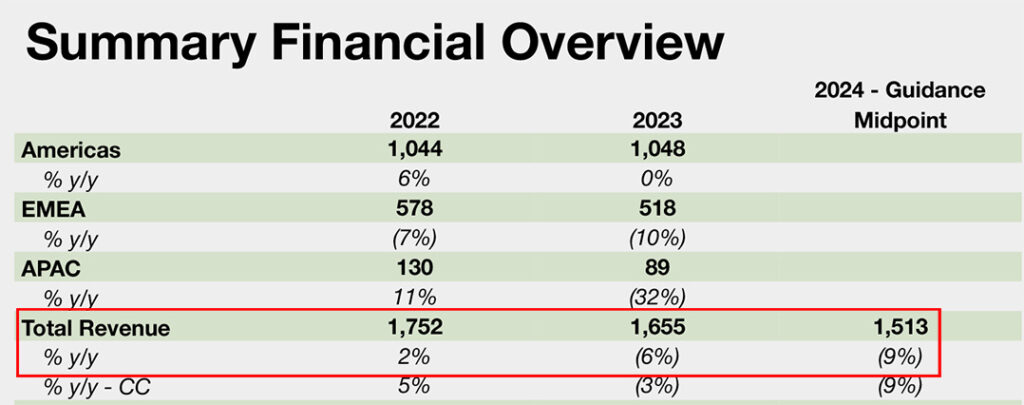
For the full year of fiscal 2024, the midpoint of the new downwardly revised guidance is $1.513 billion. Total revenues in fiscal 2023 were $1.655 billion which means the company expects fiscal 2024 to be down 9% compared to last year. And as you can see from the table I’ve included here, this is the second consecutive year of revenue declines for Sonos – a formerly hot tech company.
The Biggest Boogeyman
No doubt about it, the biggest boogeyman is the app disaster and all the self-inflicted damage it is causing the company. On a conference call with analysts, Spence said “It was the magic of the Sonos experience that brought me to the company twelve years ago… That’s why it’s so painful to let customers down the way we have with our new app.” He goes on to assure analysts that he is committed to “making this right with our customers and partners.”
It remains a mystery to me how they could possibly have botched this new app rollout so badly. This is a technically savvy company that virtually created the wireless music system category.
New App Based on Modern Programming Language
To be sure, the new app was a completely new design, not just a fresh new face on the existing backend. Rather, it is a whole new base code-level rewrite to update the app to more contemporary standards. It includes an all-new modular developer platform based on modern programming languages that Spence says will allow them to drive more innovation more quickly in the future.
This new app, Spence told analysts, was not just a new app, but a complete redesign of its entire system, including player-side updates, and a new cloud-based infrastructure. Spence called it “…an enormously complex undertaking.” You would have thought that with this level of complexity, the company would have planned the update really carefully and would have been extremely careful about the rollout. That’s a lot of moving pieces – a lot of opportunities for something to go wrong.
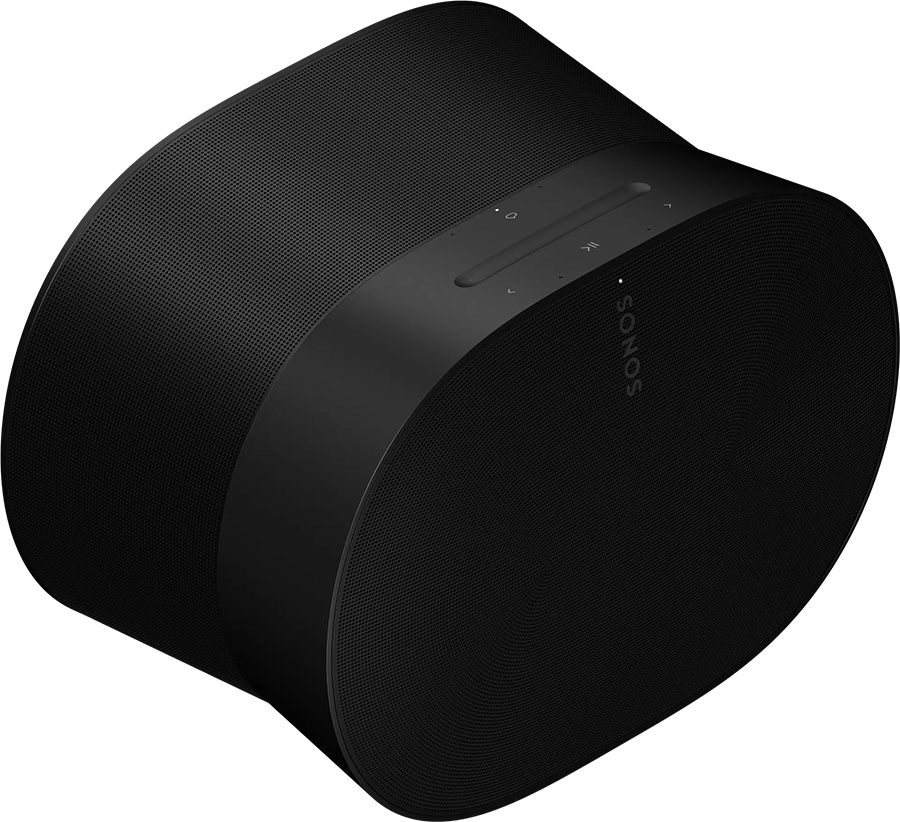
CEOs Imperative for Sonos to ‘Move Faster’ Backfired
Yet in explaining what went wrong, Spence said, “Since I took over as CEO, one of my particular points of emphasis has been the imperative of Sonos to move faster. That is what led to my promise to deliver at least two new products every year – a promise we have successfully delivered on. With the app, however, my push for speed backfired.”
I’m finding that explanation hard to believe. Simply saying that they moved too quickly conflicts with my impression that Spence is a pretty smart guy. Smart enough to have seen the danger in the complexity of such a massive systemic overhaul, and the danger that it presented. It certainly seems like advanced and complete rounds of testing were called for – and if they did this, then please explain how they missed so many issues.
A Worse Customer Experience Turns Into ‘A Headwind’ to Existing Model Sales
Notably, Spence admitted to analysts that what has resulted is a massive screw-up, with “far too many of our customers…having an experience that is worse than what they previously had.” And he’s probably sugar-coating the situation a bit.
The app situation has become a headwind to existing product sales, and we believe our focus needs to be addresing the app ahead of everything else.
Patrick Spence
Since the app launched just a few weeks ago, the company has published no fewer than nine updated versions, trying to fix bugs and restore functionality to the system.
A Three-Step Plan to Revive Its Reputation
To focus on the situation, the company will delay two new products previously scheduled to ship in Q4, now pushed back into next year. Spence outlined his three-step action plan to revive Sonos’ reputation.
- Put his best people on it, like Nick MIllington – the creator of the original Sonos experience – and Tom Conrad – a board member with 30 years of software experience.
- Increase their investment in customer support to enable quicker and more responsive engagement.
- Win back Customers and Partners – Spence says Sonos will roll out special programs “to both support and thank our customers and partners…” The goal, he added, is to “turn dissatisfaction to delight.”
Plan Will Be Costly
These programs are starting immediately. Remember, Sonos is already in its fourth quarter of fiscal 2024 which ends at the end of September. They only have about a month and a half left to try and turn this situation around.
It won’t be cheap… Spence says the company expects to spend somewhere between $20 million to $30 million on the project. That’s a heavy load of extra expense, but Spence says it is “necessary to right the ship for the long term.”
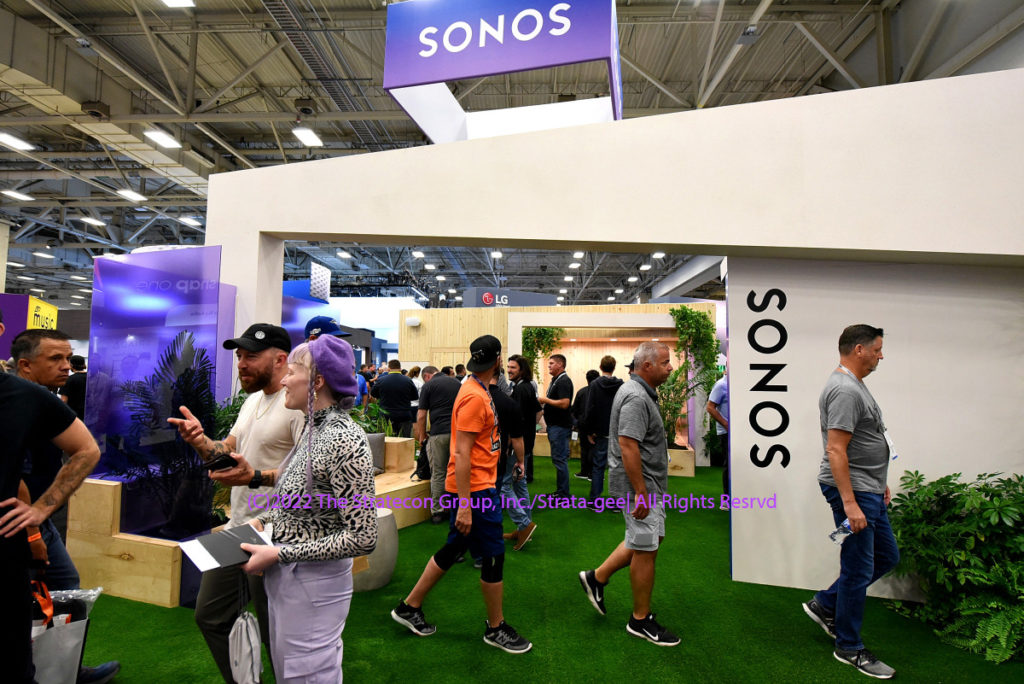
Company Announces Layoffs Costing Between $9M to $12M
On Wednesday this week, one week after Spence told analysts that they would increase their investment in customer support, Sonos filed a Form 8-K with the SEC saying it was cutting 6% of its workforce – a reduction of over 100 workers. It’s hard to square this news with the vow to increase support for consumers and dealers.
The company estimates the workforce reduction will cost them between $9 million to $12 million in “restructuring and related charges.” Of that total, about $6 million to $8 million will go to “employee severance and benefits” costs.
It is not clear if this is part of the $20 million to $30 million project to revitalize Sonos’ reputation.
Will Spence’s Plan Be Enough?
Throughout Spence’s presentation, a thought kept popping into my head – Will this be enough to get consumers back? Once a reputation is lost, it can be a painfully long process to get it back. Apparently, I wasn’t the only one questioning that as during the Q&A session on the analyst call, this question came up from Erik Woodring, an analyst with Morgan Stanley.
“Patrick, I know you guys are alluding to the $20 million to $30 million of costs in the near term. I’m just wondering if you’d take a step back and think about the potential reputational damage that you could have from this app update. Could that be longer lasting and more [cost intensive] than just $20 million to $30 million? I mean, if you go through [it], I’m sure you have a number of message boards. There’s a lot of backlash.
“And so I’m just wondering if there’s a longer-term plan here in place outside of fixing the app and promoting. What else [do] you have in store to try to get those customers that have either been loyal customers or new customers that were potentially considering Sonos products to actually come back after this?” [Emphasis added]
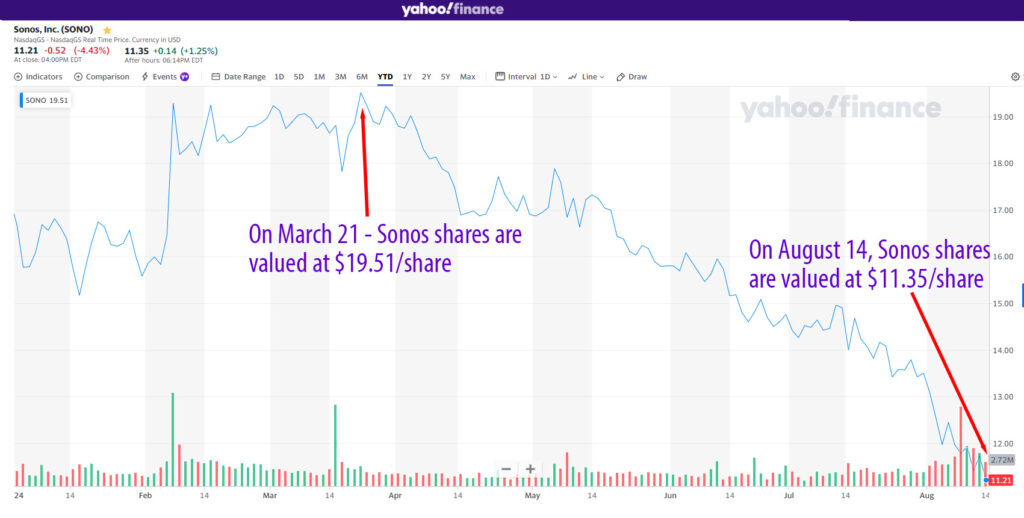
Consumer Anger Runs Hot as Problems Abound
Like Erik apparently, I’ve been monitoring several blogs and discussion boards during this Sonos crisis. The level of anger has been intense with emotions boiling over. One customer said he and his wife have been forced to just listen to music off their iPhone’s tiny speaker because their entire Sonos system isn’t working. He was furious. Many posts have called for the Sonos CEO to resign. I lost count of how many posts said that this is the worst experience they have ever had with any electronics brand.
And this has been going on for weeks. Sonos took years to build its reputation with consumers, yet in a matter of weeks, it has absolutely been hurt…and hurt bad. Like Morgan Stanley’s Woodring, I suspect that Spence is underestimating the effort it will take to revitalize it. According to Spence, by fixing the app and rolling out innovative new models, Sonos users will come back into the fold. Easy peasy…
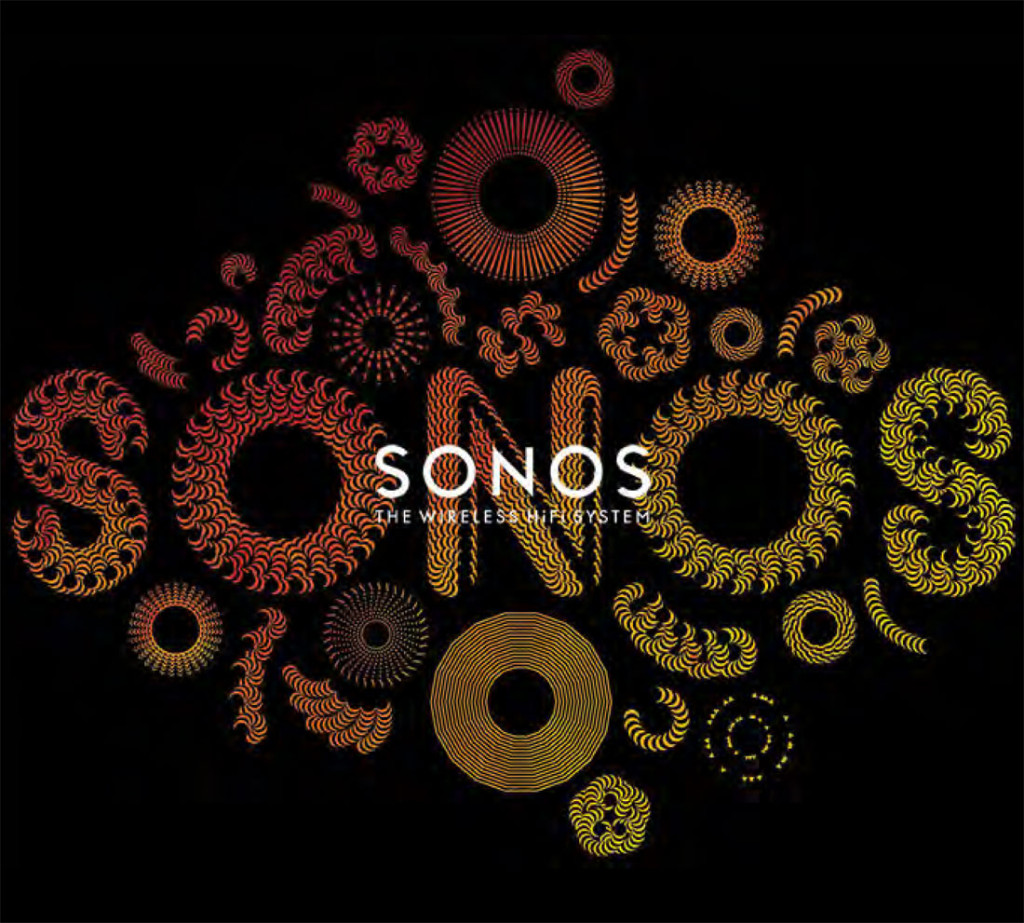
Integrators Equally Angry as App Causes Support Issues They Can’t Solve
I have also heard from several integrators who have told me they have dropped Sonos from their assortments. If a client specifically requests Sonos, they will get it for them. However, the dealer will not proactively show or recommend Sonos. Several told me that this situation has cost them in time and money – not to mention strained customer relationships – for something totally out of the integrator’s ability to address. They feel burned by the company.
However, this week I have seen one tangible effort by the company to try and improve its status with dealers. In an emailed letter to dealers this week, Sonos rolled out “four benefits” to try and help compensate dealers during this difficult time with Sonos. These four benefits are shown below…
- Eliminating Annual Minimums for 2024 – The company is waving minimum purchase requirements
- Extending Dealer Tiers into 2025 – Along the same lines as above, dealers maintain their current status into 2025, even if they fall below their previously required purchase level
- Free shipping on all orders through 2024 – All dealers will earn free shipping no matter the order size for the remainder of 2024 (this is a perk for their Platinum dealers, now extended to all dealers)
- 20% Off Next Order – The company will give all dealers a one-time special 20% discount on the next order as a way to compensate them for their extra Sonos headaches the last couple of months. Of course, it also helps Sonos to (hopefully) pump up their orders a bit
To me, the first two items are not really what I’d call generous. Clearly, dealer orders are down, mostly through no fault of their own, so it is simply pragmatic to suspend these requirements. The second two items are only beneficial if the dealer orders more Sonos products. So it seems to be a touch self-serving for the company, don’t you think?
Learn more about Sonos by visiting sonos.com.







Karma at its finest is all I will say! The one advantage being a software first based company Sonos had was their app, and once again they let their heads get in the way!,,,